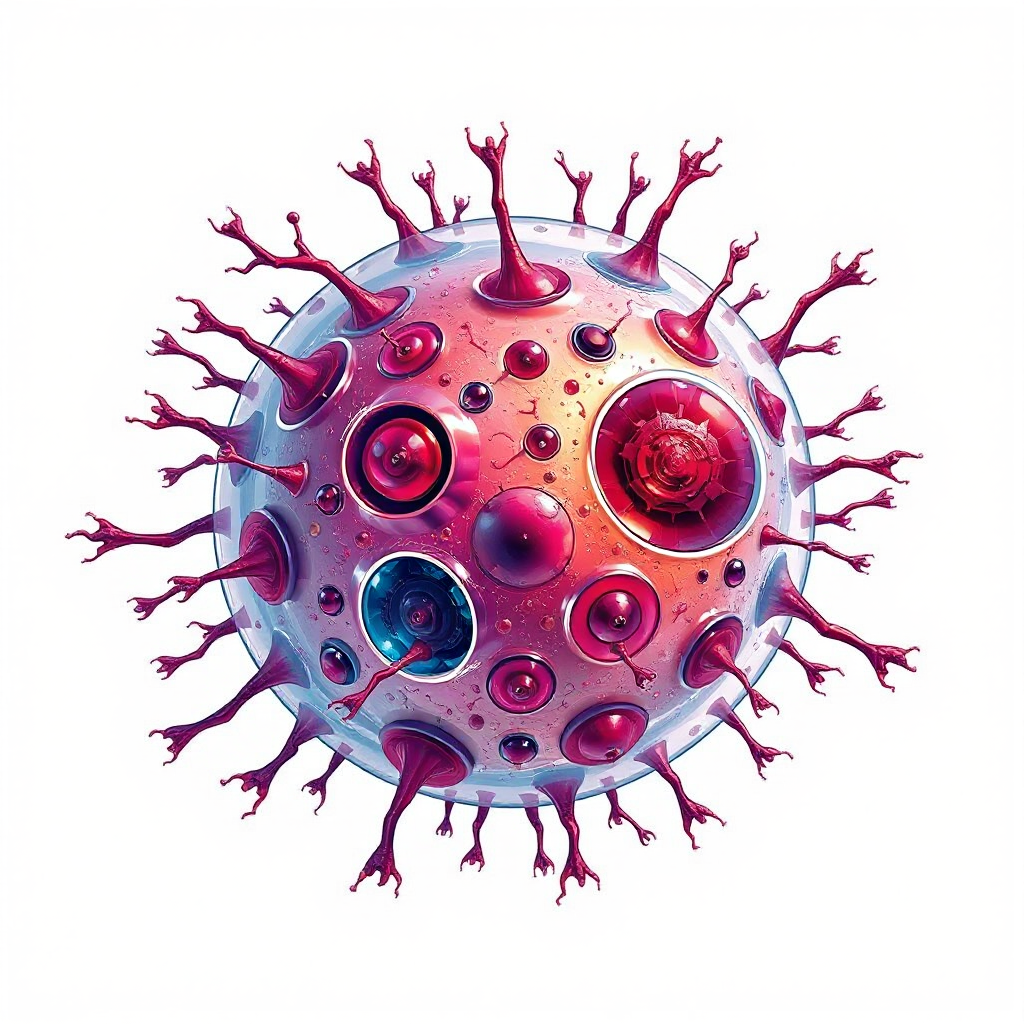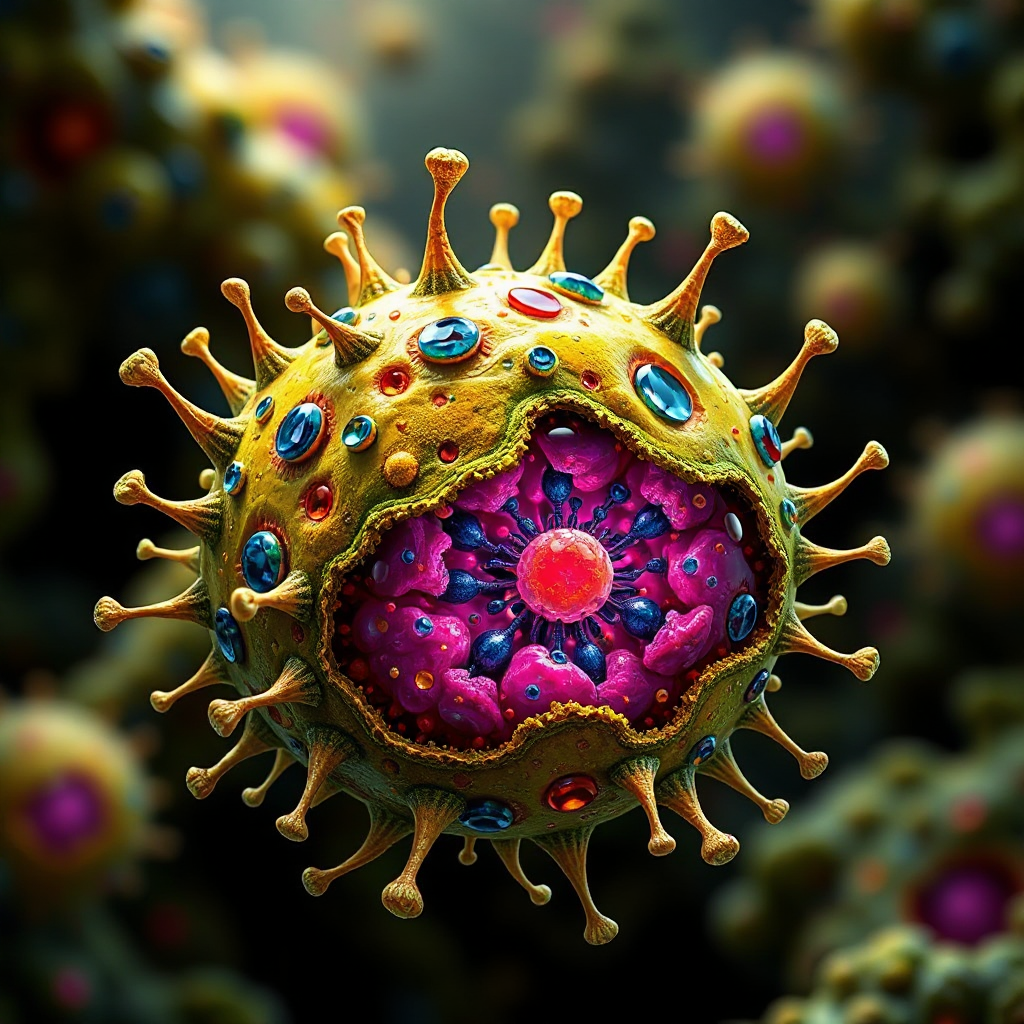What Is Primary Effusion Lymphoma and Its Key Characteristics

Primary effusion lymphoma is a rare and aggressive type of B-cell lymphoma. It develops in body cavities such as the pleural, pericardial, or peritoneal spaces, where it causes fluid buildup instead of forming solid tumors. This condition primarily affects individuals with weakened immune systems, especially those living with HIV. Among HIV-associated non-Hodgkin lymphomas, it accounts for about 4% of cases. Unfortunately, PEL has a poor prognosis, with a median survival time of just five months. Early detection and treatment are critical to managing this life-threatening disease.
Key Takeaways
Primary effusion lymphoma (PEL) is a rare, fast-growing cancer. It causes fluid to collect in body spaces instead of making lumps.
Symptoms include trouble breathing, chest pain, belly swelling, fever, and weight loss.
Finding and treating PEL early is very important. Without treatment, most people live only five months.
Using antiretroviral therapy (ART) with chemotherapy can help treatment work better, especially for people with HIV/AIDS.
See a doctor right away if you have PEL symptoms. Early care can greatly improve your chances of survival.
Symptoms and Key Characteristics of Primary Effusion Lymphoma

Common Symptoms
Primary effusion lymphoma often presents with symptoms caused by fluid buildup in body cavities. These symptoms can vary depending on the affected area:
Symptom Type | Description |
|---|---|
Pleural effusion | |
Pericardial effusion | Chest pain, discomfort, hypotension, shortness of breath |
Peritoneal effusion | Abdominal swelling and bloating |
B symptoms | Fever, weight loss, night sweats |
You may notice shortness of breath if the pleural cavity is involved. Fluid around the heart (pericardial effusion) can cause chest pain or low blood pressure. Abdominal bloating and swelling in the legs often occur when the peritoneal cavity is affected. Additionally, systemic symptoms like fever, night sweats, and unexplained weight loss—known as B symptoms—are common.
Affected Body Cavities
Primary effusion lymphoma primarily affects three body cavities:
The pleural cavity, located between the lungs and chest wall, is the most commonly involved site.
The pericardial cavity, surrounding the heart, is another frequent location.
The peritoneal cavity, lining the abdomen, is also a common site of fluid accumulation.
These areas are prone to malignant effusions, which lead to the characteristic symptoms of PEL.
Unique Features of PEL
What sets primary effusion lymphoma apart from other B-cell lymphomas is its unique clinical presentation. Unlike most lymphomas, PEL does not form solid tumors. Instead, it causes fluid containing cancer cells to accumulate in body cavities. This rare condition is strongly associated with human herpesvirus-8 (HHV-8), a defining feature not seen in other lymphomas.
PEL primarily affects individuals with AIDS, making it a rare subtype of non-Hodgkin lymphoma. It accounts for less than 1% of all lymphomas and is more common in men. Its aggressive nature and distinct presentation make early diagnosis crucial for effective management.
Causes and Risk Factors of Primary Effusion Lymphoma
Viral Associations
Viruses play a central role in the development of primary effusion lymphoma. Kaposi's sarcoma-associated herpesvirus (KSHV), also known as human herpesvirus-8 (HHV-8), is directly linked to this disease. KSHV infects specific immune cells called plasmablasts, where it establishes a latent infection. During this latency, the virus expresses genes that promote cancerous growth. For example:
The viral protein LANA-1 blocks cell death by interfering with tumor-suppressor proteins like p53.
Another viral product, vFLIP, activates NF-κB signaling, which helps infected cells survive and multiply.
KSHV also uses B cells as reservoirs for inflammatory cytokines, which drive cell proliferation and transformation into lymphoma. This viral activity makes KSHV a defining factor in the development of primary effusion lymphoma.
Evidence | Description |
|---|---|
KSHV's Role | KSHV establishes a latent infection in B cells, activating oncogenic pathways that promote cell survival and proliferation, contributing to PEL malignancy. |
NF-κB Activation | Latent KSHV infection activates NF-κB, which promotes virus latency and is critical for the growth of KSHV-infected lymphoma cells. |
Immunodeficiency Conditions
A weakened immune system significantly increases your risk of developing primary effusion lymphoma. Conditions like HIV/AIDS impair your body's ability to fight infections and cancers. This immunodeficiency creates an environment where oncogenic viruses, such as KSHV and Epstein-Barr virus (EBV), can thrive.
Co-infections with these viruses are common in individuals with HIV.
PEL accounts for about 4% of all HIV-associated non-Hodgkin lymphomas.
Most cases occur in men, with a median age of diagnosis between 44 and 45 years.
If you are immunocompromised, your risk of developing PEL is much higher, especially if you are also infected with KSHV.
Other Risk Factors
Apart from viral infections and immunodeficiency, other factors may increase your risk of primary effusion lymphoma. These include:
Risk Factor | Description |
|---|---|
Aging | A natural decline in immunity as you grow older. |
Cirrhosis of the liver | Often caused by hepatitis B or C, leading to immune issues. |
Autoimmune diseases | Chronic immune stimulation that raises lymphoma risk. |
These factors can weaken your immune system or cause chronic inflammation, creating conditions that favor the development of PEL.
Diagnostic Methods for Primary Effusion Lymphoma

Cytology and Fluid Analysis
Cytology and fluid analysis play a critical role in diagnosing primary effusion lymphoma. When fluid builds up in body cavities, a small sample is collected and examined under a microscope. This analysis often reveals large, abnormal lymphoid cells with prominent nucleoli and basophilic cytoplasm. These cells may also display high mitotic activity, indicating rapid growth.
Specialized tests, such as immunophenotyping, help identify specific markers on the surface of these cells. For PEL, the cells typically express CD45 and plasma-cell-associated markers like CD138 and IRF4/MUM1. However, they lack common B-cell markers such as CD19 and CD20. Another key finding is the presence of Kaposi's sarcoma-associated herpesvirus (HHV-8) products, such as LANA-1, within the malignant cells. These unique features make cytology and fluid analysis essential for confirming the diagnosis.
Imaging Techniques
Imaging techniques provide valuable insights into the extent of disease involvement. Computed tomography (CT) scans are particularly effective at detecting fluid collections, such as pleural or peritoneal effusions, and assessing lymph node enlargement. This information is crucial for staging the disease.
Magnetic resonance imaging (MRI) offers detailed views of soft tissues, helping distinguish between benign and malignant effusions. Positron emission tomography-computed tomography (PET-CT) combines metabolic and anatomical imaging, making it useful for identifying areas of active disease. These imaging tools not only aid in diagnosis but also guide treatment planning by revealing the full scope of the lymphoma.
Biopsy and Laboratory Tests
In some cases, a biopsy may be necessary to confirm the diagnosis. This involves collecting a small tissue sample from the affected area for histologic examination. The biopsy helps identify the type of lymphoma and its characteristics.
Laboratory tests further support the diagnosis. Genetic testing can detect abnormalities in the cancer cells, while immunohistochemistry analyzes cell surface proteins to classify the lymphoma. Viral tests for HHV-8 and Epstein-Barr virus (EBV) are also commonly performed. Together, these methods provide a comprehensive understanding of the disease, ensuring accurate diagnosis and effective treatment.
Disease Progression and Prognosis of Primary Effusion Lymphoma
Aggressive Nature of PEL
Primary effusion lymphoma progresses rapidly, making it one of the most aggressive forms of cancer. Once diagnosed, the disease advances quickly, often within weeks or months. This rapid progression occurs because PEL resists many standard chemotherapy treatments, leaving limited options for controlling its spread. Without immediate intervention, the condition worsens, leading to severe complications from fluid buildup in body cavities.
You may notice that PEL symptoms escalate as the disease progresses. For example, breathing difficulties caused by pleural effusion can intensify, or abdominal swelling from peritoneal effusion may become more pronounced. The aggressive nature of PEL highlights the importance of early detection and prompt treatment to slow its advancement.
Prognosis and Survival Rates
The prognosis for primary effusion lymphoma remains poor due to its aggressive behavior and resistance to treatment. Median survival time is approximately five months, even with therapy. Survival rates reflect the severity of the disease:
1-year survival rate: 30%
3-year survival rate: 18%
5-year survival rate: 17%
Several factors influence these outcomes. Early-stage diagnosis improves survival rates significantly. For instance, patients diagnosed at an early stage have a 1-year overall survival (OS) rate of 52%, compared to just 25% for those with advanced disease. Underlying conditions, such as HIV, also play a critical role. HIV-related complications account for a higher percentage of deaths in certain populations, such as 69% in Black Americans and 55.5% in Caucasians.
Treatment strategies further impact survival. Advanced stages of PEL carry nearly double the risk of mortality compared to earlier stages. These statistics emphasize the need for a multidisciplinary approach to improve outcomes and extend survival for those living with PEL.
Treatment Options for Primary Effusion Lymphoma
Antiretroviral Therapy
Antiretroviral therapy (ART) plays a vital role in managing Primary Effusion Lymphoma, especially in individuals with HIV/AIDS. ART helps restore immune function, which is crucial for controlling the progression of the disease. If you are undergoing treatment for PEL, combining ART with chemotherapy can improve your immune recovery. This combination, often referred to as concurrent combination ART (cART), accelerates immune system restoration, although it may not directly increase overall survival rates.
Patients who receive ART before their PEL diagnosis tend to have better outcomes. Prolonged survival is possible for those who maintain remission after chemotherapy while continuing ART. However, the absence of ART before diagnosis often leads to a poor prognosis. The National Comprehensive Cancer Network (NCCN) recommends integrating ART with aggressive chemotherapy regimens to optimize treatment outcomes.
Chemotherapy
Chemotherapy remains a cornerstone in treating Primary Effusion Lymphoma. Common regimens include CHOP (cyclophosphamide, doxorubicin, vincristine, and prednisone) and DA-EPOCH (dose-adjusted etoposide, prednisone, vincristine, cyclophosphamide, and doxorubicin). While CHOP achieves a complete remission rate of 62%, its long-term success is limited, with a 5-year survival rate of only 17%. More intensive regimens, such as high-dose methotrexate, have shown promise, achieving complete remission rates as high as 70%.
Chemotherapy Regimen | Complete Remission Rate | 2-Year Disease-Free Survival Rate |
|---|---|---|
CHOP | 62% | 71.5% |
DA-EPOCH | Improved outcomes suggested | N/A |
Combining chemotherapy with targeted therapies like rituximab may enhance effectiveness, particularly in CD20-positive cases. Despite these advancements, the overall median survival for PEL treated with chemotherapy remains approximately 6.2 months. Early intervention and tailored regimens are critical for improving outcomes.
Experimental and Advanced Therapies
Researchers are exploring innovative therapies to address the challenges of treating Primary Effusion Lymphoma. Molecular-targeted therapies focus on pathways like mTOR, NF-κB, and JAK/STAT, which drive cancer cell growth. Therapies targeting CD30 and CD38, such as daratumumab, are also under investigation.
Therapy Type | Description |
|---|---|
mTOR pathway targeting | Therapies targeting the mTOR pathway are being researched. |
CD30 targeting | Therapies targeting CD30 are under exploration. |
Proteosome inhibitors | These inhibitors are part of the experimental therapies. |
EPOCH-R2 regimen | A phase I-II trial is evaluating this regimen with rituximab and lenalidomide. |
Tabelecleucel | A phase II trial is assessing this therapy for relapsed/refractory EBV-associated disease. |
These experimental approaches aim to improve survival rates and provide new hope for patients with relapsed or refractory PEL. While still in clinical trials, they represent a promising future for managing this aggressive disease.
Supportive Care
Supportive care plays a vital role in managing Primary Effusion Lymphoma (PEL). While treatments like chemotherapy and antiretroviral therapy target the disease, supportive care focuses on improving your quality of life. It addresses symptoms, reduces complications, and helps you cope with the physical and emotional challenges of living with PEL.
Key Components of Supportive Care
Symptom Management:
Managing symptoms like shortness of breath, chest pain, or abdominal swelling is essential. Doctors may drain fluid from affected cavities through procedures like thoracentesis or paracentesis. These interventions can provide immediate relief and improve your comfort.Nutritional Support:
Maintaining proper nutrition is critical during treatment. You might experience appetite loss or weight changes due to the disease or its therapies. A dietitian can help you create a meal plan that meets your nutritional needs and supports your recovery.Pain Control:
Pain can significantly impact your daily life. Medications, such as analgesics or anti-inflammatory drugs, can help you manage discomfort. Your healthcare team may also recommend physical therapy or relaxation techniques to ease pain.
💡 Tip: Open communication with your healthcare provider ensures that your symptoms are addressed promptly. Never hesitate to share how you feel.
Emotional and Psychological Support
Living with PEL can be emotionally overwhelming. You may feel anxious, depressed, or isolated. Support groups, counseling, or therapy can provide a safe space to share your feelings and connect with others facing similar challenges.
Palliative Care
Palliative care specialists focus on enhancing your overall well-being. They work alongside your primary treatment team to ensure that your physical, emotional, and spiritual needs are met. This holistic approach can make a significant difference in your journey with PEL.
By prioritizing supportive care, you can improve your quality of life and better manage the challenges of this aggressive disease.
Primary effusion lymphoma is a rare and aggressive cancer that demands prompt attention. Recognizing its symptoms, such as fluid buildup in body cavities and systemic signs like fever or weight loss, can lead to earlier diagnosis. Establishing care with a dedicated primary care provider (PCP) plays a crucial role in shortening the time to diagnosis, which is vital for managing this disease. Early intervention improves outcomes, especially when fewer body cavities are affected or prior antiretroviral therapy has been administered.
A multidisciplinary approach enhances treatment by combining expertise from various specialists. This collaboration ensures accurate diagnosis, considers comorbidities, and provides access to diverse treatment options. If you suspect PEL or belong to a high-risk group, consulting a healthcare professional is essential. Early action and comprehensive care can make a significant difference in managing this challenging condition.
FAQ
What makes Primary Effusion Lymphoma different from other lymphomas?
PEL does not form solid tumors. Instead, it causes fluid buildup in body cavities like the pleural or peritoneal spaces. It is also strongly linked to human herpesvirus-8 (HHV-8), which is not common in other types of lymphoma.
Can Primary Effusion Lymphoma occur in people without HIV?
Yes, but it is rare. PEL primarily affects individuals with weakened immune systems, such as those with HIV/AIDS. However, it can also occur in people with other immunodeficiency conditions or chronic illnesses that impair immune function.
How is fluid buildup treated in Primary Effusion Lymphoma?
Doctors often drain the fluid through procedures like thoracentesis (for pleural effusion) or paracentesis (for peritoneal effusion). These treatments relieve symptoms like shortness of breath or abdominal swelling but do not address the underlying cancer.
Is Primary Effusion Lymphoma curable?
PEL is challenging to cure due to its aggressive nature and resistance to standard treatments. However, combining chemotherapy, antiretroviral therapy, and experimental approaches can improve outcomes. Early diagnosis and a multidisciplinary care plan are essential for better management.
What should you do if you suspect Primary Effusion Lymphoma?
Consult a healthcare professional immediately. Early symptoms, such as unexplained fluid buildup or systemic signs like fever and weight loss, require prompt evaluation. Early intervention improves your chances of effective treatment and better outcomes.
💡 Tip: Keep track of any unusual symptoms and share them with your doctor for timely diagnosis.
See Also
Exploring Intravascular Large B-Cell Lymphoma's Essential Characteristics
Defining Follicular Lymphoma: Symptoms and Key Insights
Mycosis Fungoides: A Comprehensive Overview of Cutaneous Lymphoma
